

The next stop on my trip would take me eastward to Munich. Known popularly for its beer halls and bratwursts, Munich is also the historical capital of Bavaria, the largest region in southern Germany. Munich's Old Town (Altstadt) boasts a series of elegant historical buildings, displaying the wealth and power of the region with a series of Baroque buildings. In more modern times, the city was also the host of the 1972 Olympics and serves as the home of the one of the world's most famous football clubs in the form of Bayern Munich. I had limited myself to a single day in Munich, and it was going to be a challenge to see as much as possible in the scant time available. This is a huge city that could easily deserve a week's vacation in its own right.


The journey from Zurich to Munich was longer than many of the others that I had taken by train. This trip took about four hours by rail, mostly passing through the pastoral farming country of southern Germany. As usual, there were few people awake at this early hour as my train rolled along past small towns surrounded by fields of crops. The terrain here was hilly, but far from the mountainous peaks and valleys that I had experienced in Switzerland. Unlike most of the other days on my trip, the weather on this morning was decidedly cloudy and looked potentially ominous for later in the day. I hoped that these clouds would clear up and my good fortune with sunny skies would continue for another day.

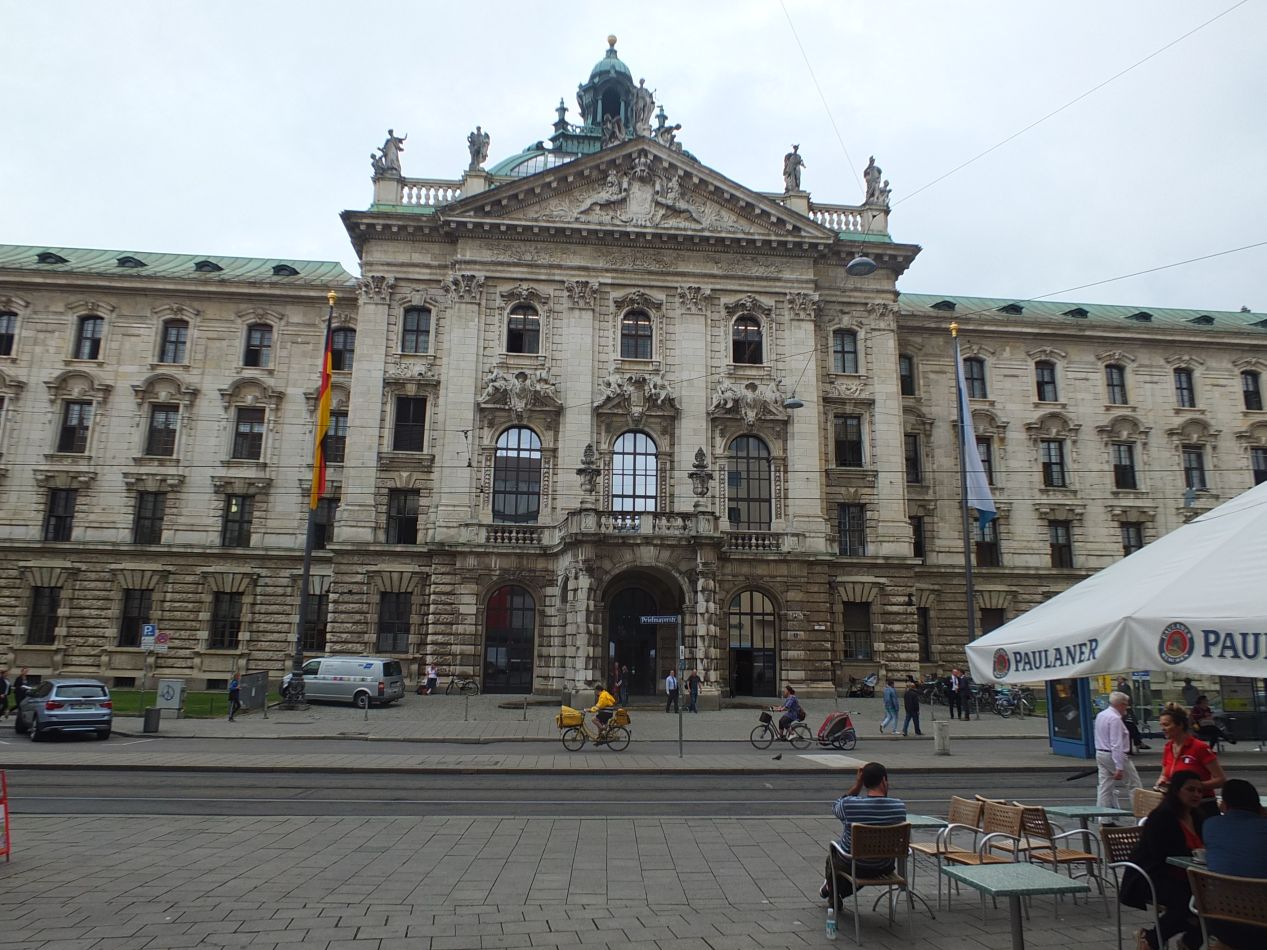
I arrived in Munich's central train station (München Hauptbahnhof), which is a noteworthy structure in its own right. This is a huge building with multiple floors of shops and restaurants, and often looked more like a shopping mall than a train station. The Hauptbahnhof was spotlessly clean and easy to navigate, as expected when using any kind of public facility in Germany. I wish that the Washington DC metro looked more like this. The exterior of the building showcased some of its historic character, with the initial train station built around 1850 and remodeled many times since. Like almost every other building in Munich, it was heavily damaged by bombing in World War II and had to be reconstructed following the conflict. I left the station from its eastern exit, which put me right outside the entrance to the city's old town district.


This little arch marked the opening into Neuhauser Strasse, the pedestrian boulevard that runs through the historic central section of Munich. The archway is known as Karlstor, and this used to be a gateway that led into the city through the medieval fortifications that encircled it. When I researched this subject online, I found out that there was originally a wall that ran around Munich to either side of this spot, and the gateway even crossed over a moat filled with water! There was a public fountain located in that spot now, which perhaps was a way of recalling the distant past of this entry point. Karlstor certainly looked nothing at all like the medieval illustration of this spot. Inside the old town, pedestrians strolled past a series of stores located on the ground floor of historic buildings. It was quite lively for an early Tuesday afternoon, with a number of people stopping to pick up lunch. I was headed towards the center of the city where some of the most famous landmarks were located.




One of the first destinations that I came across was this church known as the Bürgersaalkirche ("Citizen's Hall" in English). Although this wasn't on my planned list of stops, it was right on the way and I popped inside for a few minutes. The Bürgersaalkirche was built during the 18th century for the use of a Marian congregation. The building was divided between an upper and lower floor, with visitors first entering the lower portion from the street outside. There was a small chapel here with the stations of the cross depicted in lifesized statues to either side. In the back, there was also a small museum with various religious artifacts owned by the church. On the upper level was the main church, a heavily gilded Baroque interior with an elaborately painted ceiling. This was a style of church design that I would be seeing repeatedly over the next few days, a different sort of setup than medieval High Gothic or the austere simplicity of some of the Calvinist churches. For a place that I hadn't intended to visit, this was a fun little stop.




Only a short distance down the same main street was this larger church, St. Michael Kirche. I always have an affinity for churches that share my own name, and this one had a statue of the archangel stabbing Lucifer with a spear above the main entrance. The interior proved to be larger than the building looked from the street, with a very high ceiling providing an immediate contrast to the more intimate feel of the Bürgersaalkirche that I had just visited. This is the largest Renaissance church built north of Italy; it was constructed by the Jesuits to serve as a center for the Counter Reformation in the 16th century. Everything in the St. Michael Kirche seemed to be either white or gold, and the repeated use of arches was intended to serve as a sign of the triumph of Catholicism against its Protestant rivals. It was hard to avoid feeling at least somewhat impressed by the nature of this place. The overall effect seemed to be a bit over the top, trying to intimidate the visitor with its size and grandeur. I couldn't help but think of the old Dutch churches that I had visited in Delft and Amsterdam, which also used the same kind of white coloring but in a very different and simpler way. Those places never would have included these elaborate and enormous paintings surrounded by white and gold trim. At times, it felt like my trip was turning into a seminar on European religious architecture over the last thousand years. 


Here are a couple quick pictures of some of the merchandise on sale in the stores lining Neuhauser Strasse. Bayern Munich gear was omnipresent, and I wished that I could have had a chance to see the team or at least their stadium. There was no available time though, and the month of July is about the worst time of the year to try and see one of the top European football clubs. They're all out doing international tours to raise brand awareness (and money). Perhaps another time.

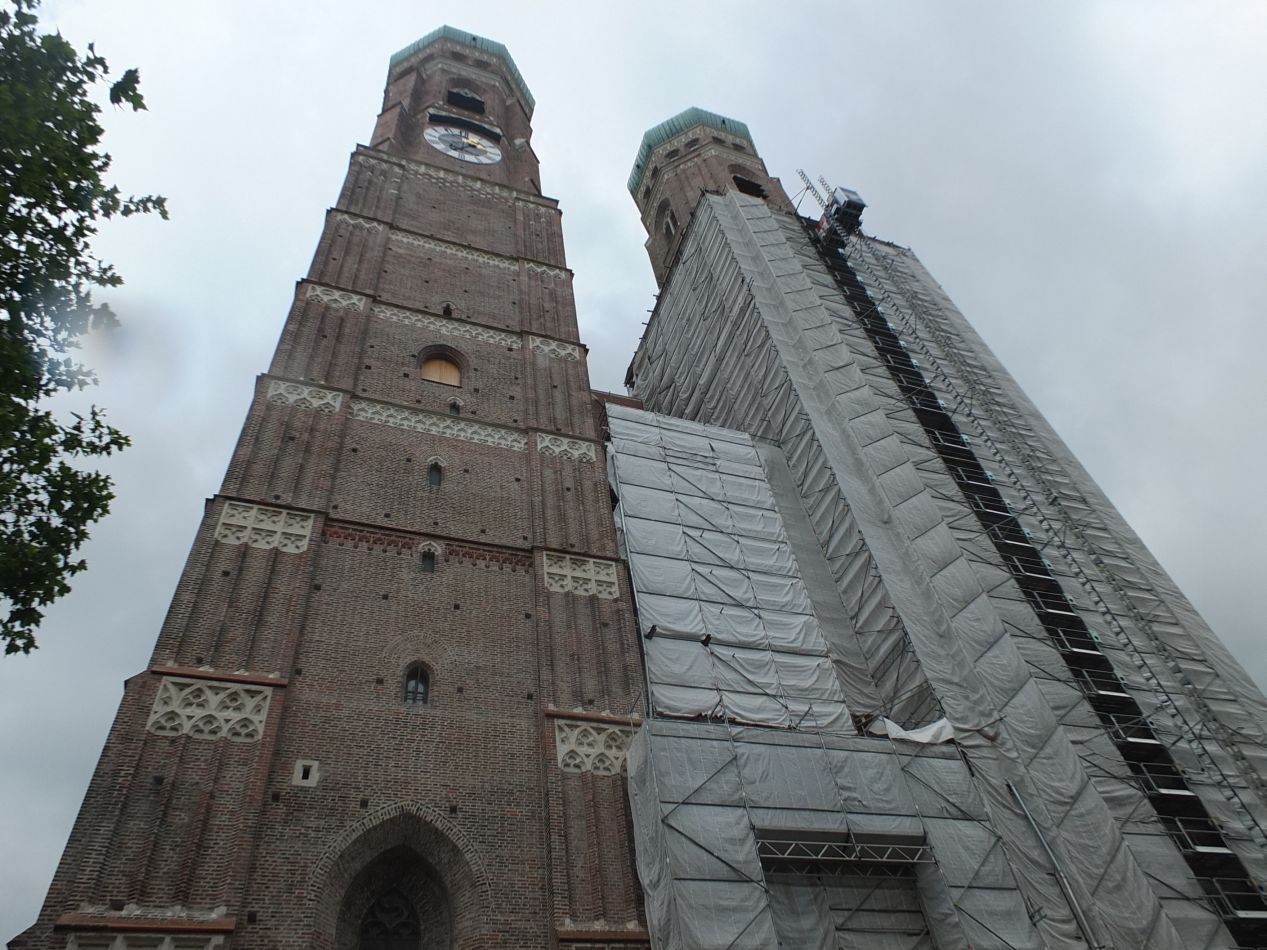


My next stop was... yet another church. I honestly wasn't doing this deliberately, they simply all happened to be very close to one another as I walked towards the center of town. This one was Munich's cathedral, or "Dom" as it's known in German. The building was also referred to as the Frauenkirche, with the official English translation rendering as the Cathedral of Our Dear Lady. The Dom's best-known feature is the pair of green tipped towers that rise above the rest of the building, easily visible from the main street despite the intervening buildings. The rest of the structure was made up of bricks and looked unremarkable from the outside. There was also quite a bit of construction taking place which made it hard to get a good picture of the exterior. The Dom was constructed in the late 15th and early 16th centuries, and unlike earlier medieval cathedrals was built in a span of only two decades. It was almost completely destroyed by bombing during World War II, and most of what can be seen today is a reconstruction. The inside of the Dom used the familiar Gothic design, with a high vaulted ceiling, two rows of pillars running down either side, and stained glass on the walls. Maybe it was due to the fact that I had seen so many Gothic cathedrals at this point, but I found this one to be somewhat on the bland side. Perhaps the most noteable feature was the row of saints mounted on wood paneling that ran back behind the main altar on either side. I had been expecting this cathedral to be the religious highlight of my stop in Munich, but there just didn't seem to be that much here to see. I found the St. Michael Kirche to be the more interesting structure in its own bombastic way.




The historic heart of Munich is the Marienplatz public square, with two different town halls ringing the open area. Pictured above was the new town hall (Neues Rathaus), a glorious Neo Gothic structure designed to look as though it came out of the medieval period. It was actually built in the 1890s because the city's administration needed additional space that had outgrown the original town hall. The Neues Rathaus seemed to be the spot where most of the tourists in Munich were gathering, with scores of people walking around and eagerly snapping pictures of the highly ornamental facade. The building is best known for the clock chimes that ring on the hour, which produce a display of animated clockwork figures up on the side of the structure. When my parents visited Munich a number of years before my trip, this was one of the things that they most vividly remembered seeing. There was also a statue depicting angels slaying demons in the middle of the Marienplatz, and a commemorative plaque for the 20th Olympic games that took place in Munich in 1972. This bustling plaza was the central hub of activity, with all of the other pedestrian streets radiating out from its central position.




Unlike many of the other town halls that I had visited thus far, the Neues Rathaus was freely open to the public. Inside it felt like a combination of a cathedral and a giant oversized hunting lodge. There were all of the familiar Gothic elements here, between the arched ceilings and the stone pillars, but they were combined together with multiple levels of stairs and what almost felt like a maze of twisting passages. I couldn't help but think that this would be an amazing place to play Hide and Go Seek as a child. Then there were the stained glass windows. Typical for a structure that wanted to emulate medieval stylings, the windows in the Neues Rathaus were beautifully illustrated in a veritable rainbow of colors. Rather than depict religious subject matter, they were instead devoted to cities, buildings, and famous people associated in some way with southern Germany. I've highlighted one such example in the photograph above. Some of the scenes portrayed in stained glass were far ranging topics: there was one little corner that had pictures of Niagara Falls and the Statue of Liberty underneath a pair of American flags. All of these windows reflected careful, meticulous craftsmanship. I hadn't been expecting anything like this when I entered the town hall, and this whole building came as a pleasant surprise.

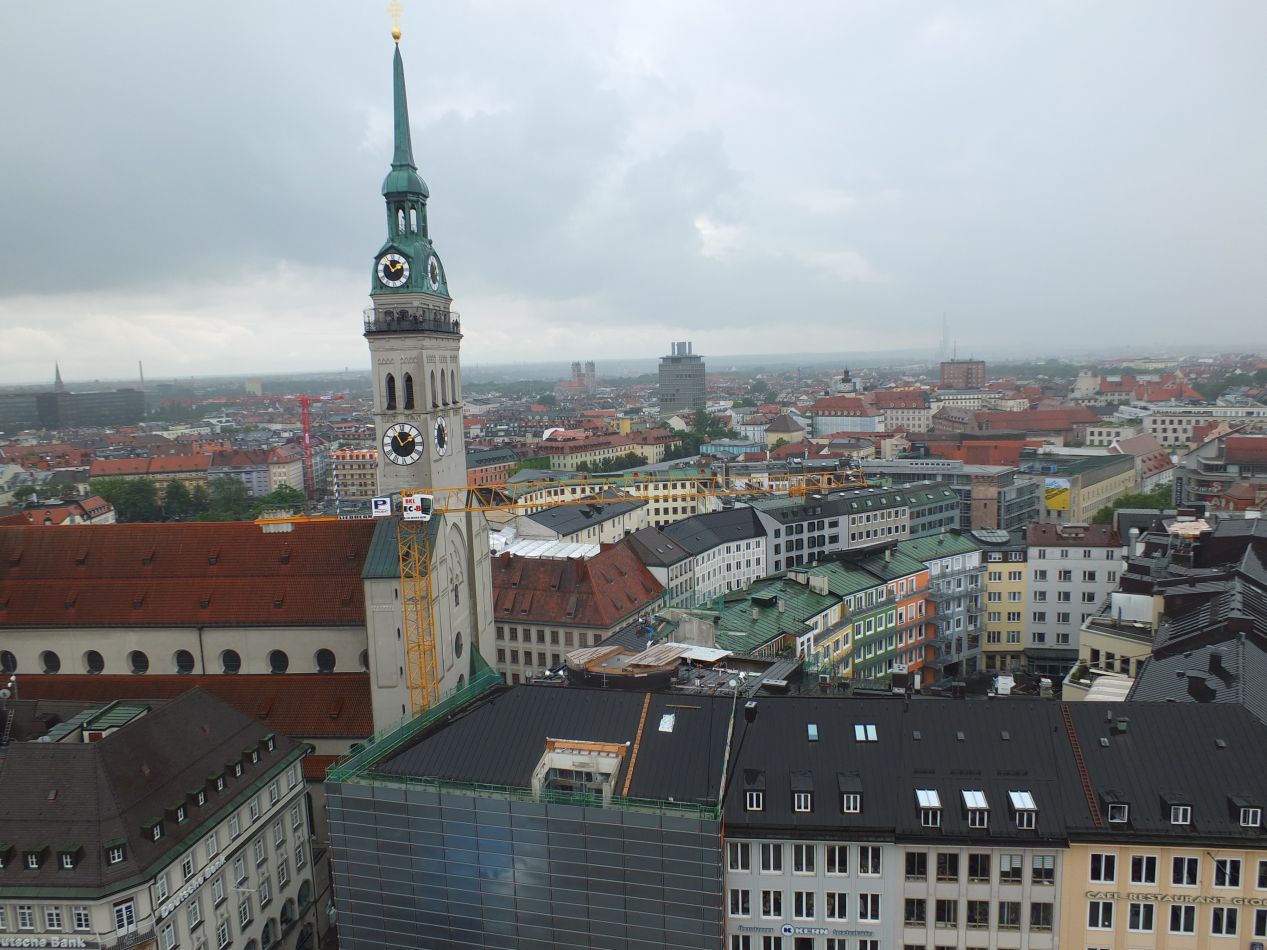


I had actually gone into the Neues Rathaus to take the elevator up to the observation deck at the top of the central clock tower. While this might not have been quite so high up as Cologne Cathedral, the vantage point was still plenty to see above the buildings and get a sweeping view of central Munich. Off to my east, I could see the white structure with pointed tops that had served as the original town hall. Back behind me to the west lay the Dom, and from up here it was more obvious that this was the largest church in the city. Immediately below me was the Marienplatz, the view marred slightly by the construction taking place on one of the buildings at its far end. The gloomy weather that had hung over the city for the last few hours also finally began to turn to rain, and I noticed umbrellas starting to pop out above the heads of the people walking below. Standing in an exposed position at the top of a clock tower while the rain began to fall didn't seem like a very good idea, and I headed back inside once I'd finished looking around.


The clock was also about to ring a new hour, and crowds were gathering in the square to walk the small mechanical figures come out. Unfortunately this was when the skies opened up in earnest, beginning a steady rain that would continue for the rest of the day. While I did my best to take a few pictures of the little clockwork men in medieval costumes, I didn't get a very good view of what was going on. When I passed back through the Marienplatz later the same day, it was still raining just as hard, maybe even harder. This wasn't a great day for watching this kind of public show. At least I managed to see it at all - I wasn't sure if the weather would stop the figures from appearing.


Pictured here is the old town hall (Altes Rathaus), a building that actually does date back to the 14th century instead of simply looking like it. The structure was renovated several times over the years, with the current version being a Gothic restoration that supposedly resembles the original construction. There's actually a road that runs through this building now, which is one of the stranger aspects of the Altes Rathaus. Wikipedia also has a note about this building stating that this was the location where Joseph Goebbles gave a speech in 1938 that led directly to the Kristallnacht pogrom. Needless to say, that information is not mentioned when visiting the building. (I tried to find the location of the beer hall where Hitler carried out his abortive putsch in 1923, but the structure hasn't existed for a long time now, and that's probably for the best.) Anyway, the Altes Rathaus didn't seem to have a tourist entrance, or maybe I just missed it due to the rain pouring down. I kept going onward.




The biggest tourist attraction in Munich is arguably this location, the Hofbräuhaus. This is a famous beer hall, one that stretches across three floors and can accomodate several hundreds guests at once. The Hofbräuhaus was originally built by one of the dukes of Bavaria in the late 16th century, and it was first opened to the public in 1828. Whenever one sees pictures of the Oktoberfest celebrations, the Hofbräuhaus is typically the backdrop for the carousing. Today, this is where all of the tourist buses inevitably make a stop, and the Hofbräuhaus is happy to lean into this role by dressing all of its employees in traditional German garb while playing various Bavarian folk tunes. There were doing great business even on a rainy weekday afternoon, and there were several gift shops next to the building selling Hofbräuhaus merchadise. I wasn't interested in eating or drinking at the moment, so I simply wandered through the restaurant taking pictures. Somewhat amazingly, no one stopped me or said anything as I walked right through the bottom two floors. Most people really do seem to assume that you know where you're going and that you belong there if you can manage to look the part. Up on the top floor was the traditional banquet hall, displaying faded banners on the walls and an enormous chandelier hanging from the ceiling. It was closed at the moment, and I managed to peek my camera inside to take a picture of the empty room. This would have been a great place to stop and relax if I'd had more time available.


Instead, I proceeded on to my last major destination for the day, the Residenz palace. This was the former home of the ruling family of Bavaria, the Wittelsbach line, who at various different times held the title of elector, duke, and eventually king. I was not terribly familiar with this particular dynastic family, but a little research afterwards revealed that they were one of the most powerful families in the Holy Roman Empire, and retained power in Bavaria right up until 1918. There's even a guy named Franz Wittelsbach out there today who still holds the unofficial title Duke of Bavaria. (For you true history nerds, he's also a direct descendent of James II of England and holds the Jacobite claim to the British throne, although I don't think anyone still cares about that.) Anyway, the Residenz is a grand palace in the fine tradition of other hereditary European monarchs. The oldest parts date to the 16th century, but the Residenz was greatly expanded over the centuries until reaching its current size of 130 rooms. What's really amazing about this place is that nearly every room is open to the public, a far cry from the small handful that are on the tours at places like Versailles or the Schönbrunn. This was a perfect place to spend the remainder of a dreary rainy day.




The Residenz walking tour first led into this enormous hallway, known as the Antiquarium. It was built around 1570 for Duke Albert V and designed to hold his collection of antiques; it is supposed to be the largest hall designed in Renaissance fashion north of Italy. While the hallway made for quite a lavish spectacle and had a ridiculous amount of attention to detail, it was also laughably gaudy and over the top. Every small alcove in the Antiquarium held a statue from the classical period, every inch of space on the walls and ceiling was painted with elaborate images, and even the floor tiles were made out of marble in two different shades. If there's one thing I learned while touring this museum, the Wittelsbach family didn't know when to say enough was enough.




The same lack of restraint was on display in this series of rooms, known as the Ancestral Gallery. This section of the palace was constructed in the early 18th century, and instead of using Renaissance-inspired design, the architect decided to use the prevailing Baroque style in the gaudiest manner possible. The decorations here could fairly be described as Rococo, the term used for the late Baroque style that took frilly ornamentation to its limits. The Ancestral Gallery was full of portraits of different members of the Wittelsbach family, surrounded by fanciful creatures and twisting vines all made out of gold. In fact, the gold-worked ornamentation covered almost every bit of the walls and even expanded onto the ceiling when it ran out of space on the sides of the hallway. The opulence that was being flaunted here felt incredibly tacky to me; did the dukes of Bavaria really feel so insecure that they needed to surround their own portraits in a hallway of almost solid gold? Well, some of the later members of the family turned out to be genuinely insane (like "Mad King" Ludwig), so perhaps they were that insecure.




After these initial sections on the ground floor, the Residenz museum largely left visitors free to wander around the rest of the palace and explore at their own pace. Due to the weather outside there were relatively few tourists on this particular day, and once I left the gaudy halls near the entrance behind, the upper levels of the palace were almost deserted. It was a little bit weird to be wandering through one sumptuously decorated room after another with only the occasional other traveler to keep me company. And the place just kept going and going and going! There were close to 100 rooms open to the public, and it takes a long time to walk through all of them. I passed by the china collection of the reigning family, which was laid out on a table large enough to seat a hundred diners at once. I saw endless paintings, huge tapestries that covered entire walls, and sculptures galore. I came across the main church of the palace, and then a second smaller chapel that was even more luxuriously decorated, with even the floor used as a mosaic of precious marble.

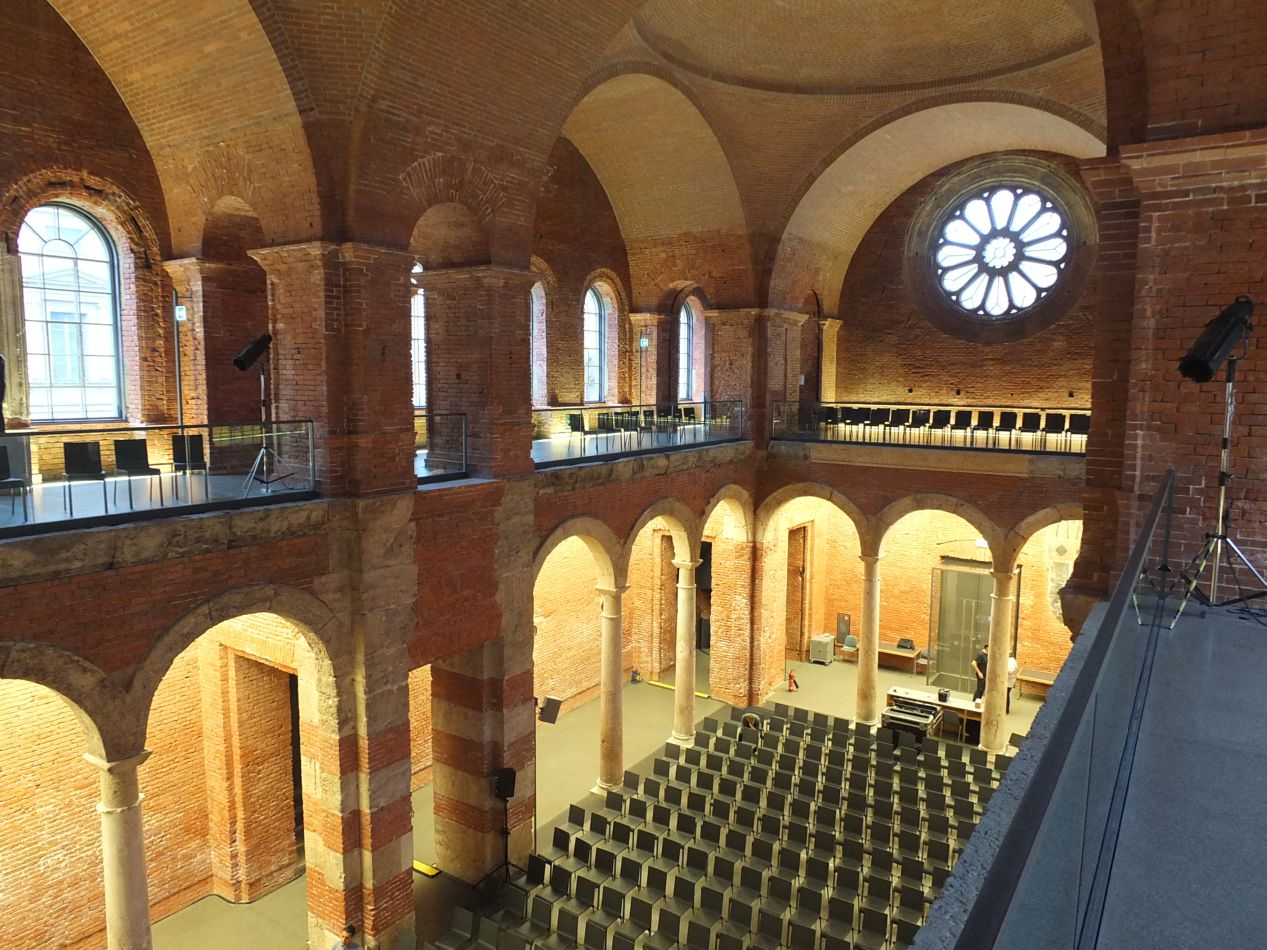

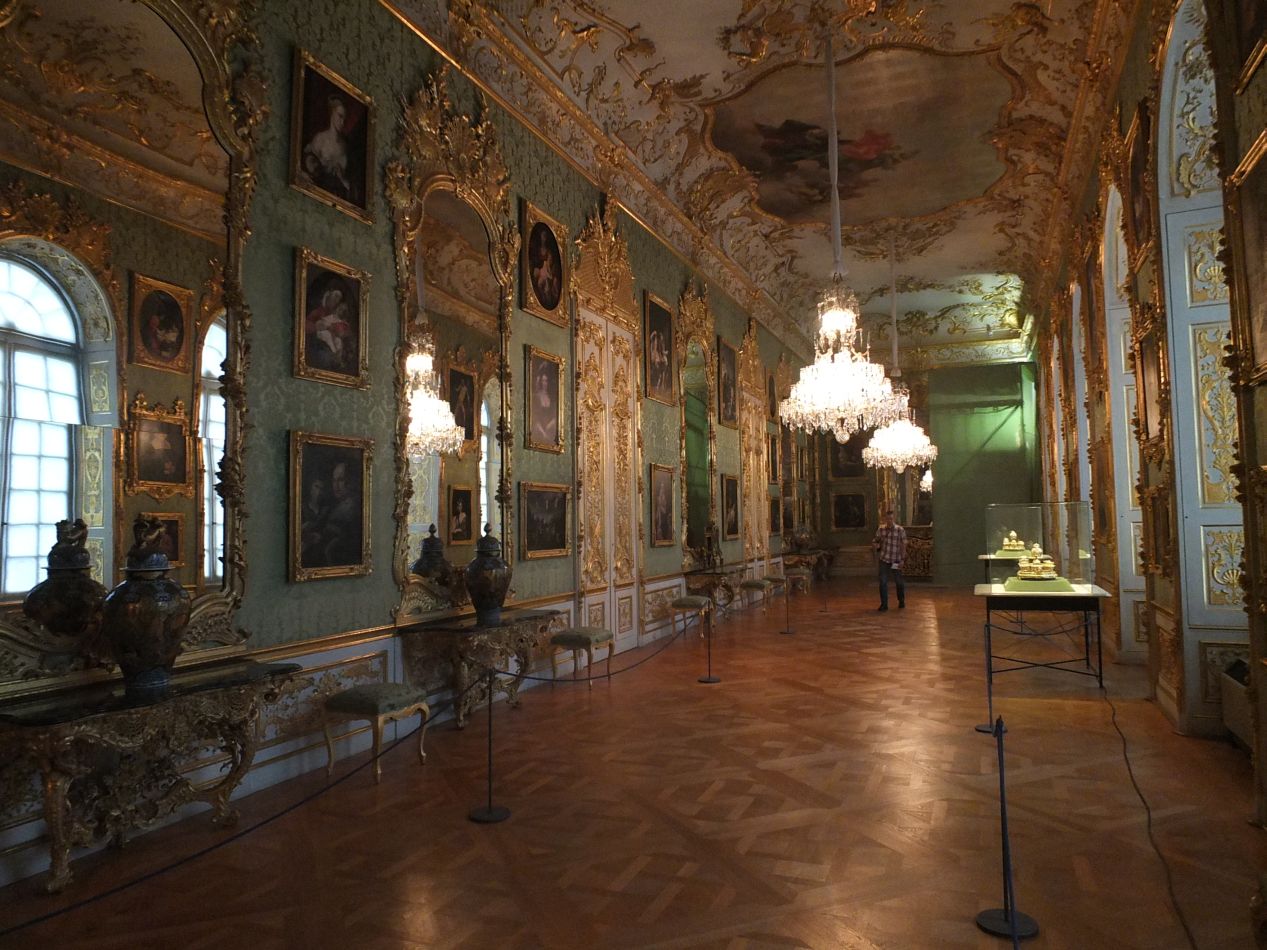
Yeah, the place still kept on going. I wanted to display more of the pictures to provide a sense of what it was like walking through the Residenz museum. Even this was only a small selection of the pictures that I took, which were themselves a subset of the seemingly endless rooms. I started to feel frustrated, even a big angry at the absurdity of it all, as I passed into the THIRD church located in the Residenz, this one a larger structure of red brick. Who could possibly need all of this stuff? What purpose did it serve to build so many ludicrously expensive rooms? I suspect one reason why most of the famous European palaces keep the majority of their rooms closed to the public is to avoid uncomfortable questions like this. You don't have to be a Marxist to see this kind of spectacle and feel that this much concentration of wealth and luxury into the hands of one family was fundamentally unjust.

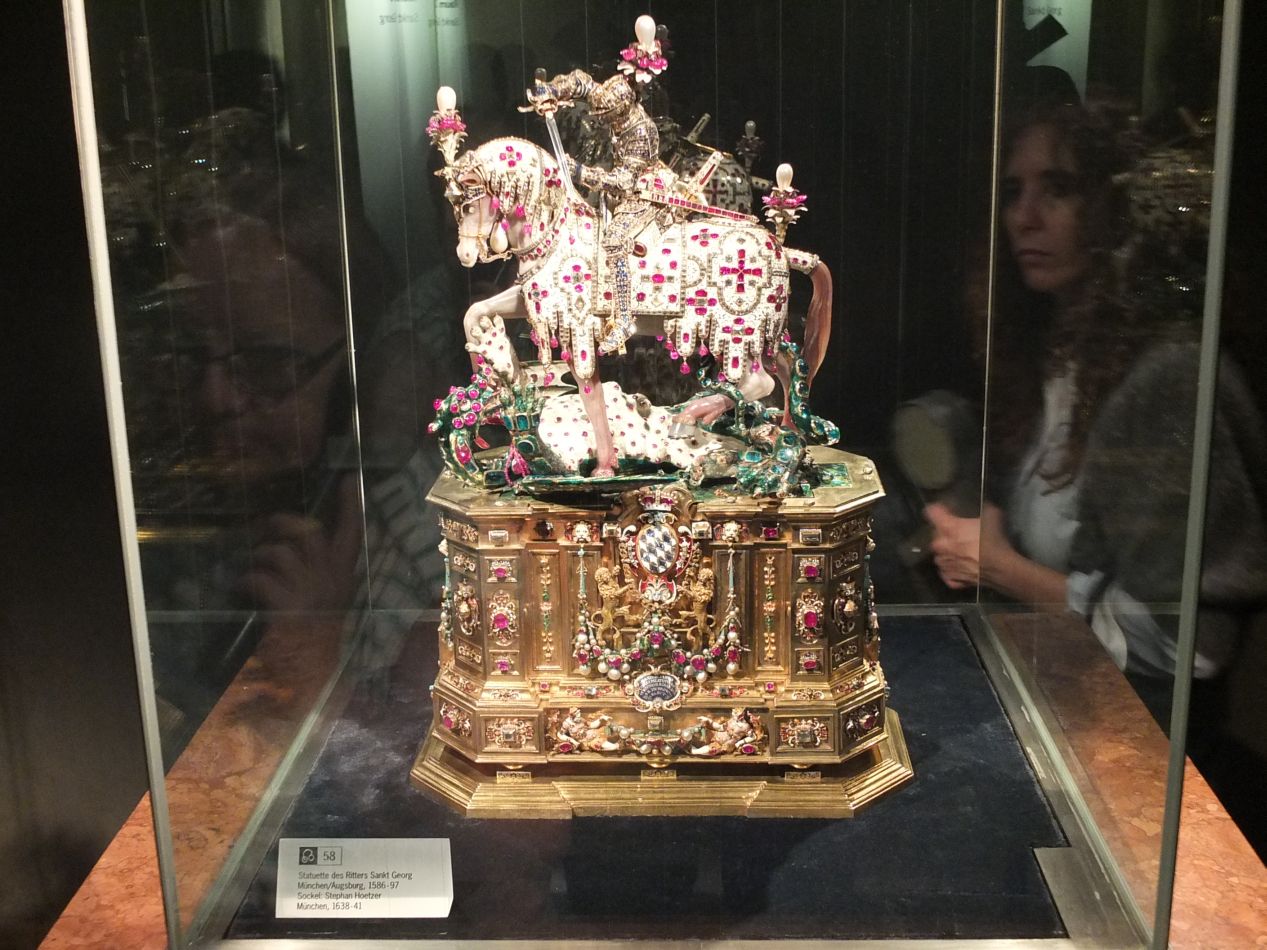


In addition to touring the rooms of the Residenz, visitors can also pay an additional fee to view the artifacts stored in the treasury. These were effectively the crown jewels of the Wittelsbach family, with the displays containing necklaces and earrings, swords and mitres, all made out of gold and precious gemstones. I counted at least five different crowns on display, with new ones made for each new royal coronation ceremony. As I'd noticed before, this reigning family was unashamed to showcase their wealth in the most conspicuous ways possible. I did find myself liking the little statue of a knight despite my better instincts, a depiction of St. George studded with little rubies all over the horse's barding. That was the one thing that I could see myself owning rather than immediately selling for whatever a purchaser would pay.


By the time that I was ready to leave the Residenz, it was time to stop sightseeing and head for my hostel. The city of Munich has many more sights that I would have liked to see, with some excellent museums and gardens along the Isar River and the Olympic park a little bit off to the north, but there was only so much that I could do in half of one day. It was still raining heavily and I needed to eat and dry off. My hostel was located back near the Hauptbahnhof, and I had to search a bit before I was able to find it on a side street. It was a fairly generic building as these things go, but it was clean and warm, and that was enough given the poor weather. I would be heading on to Vienna the next day, across the Austrian border to the seat of power for a European ruling family even wealthier than Bavaria's Wittelsbachs. There would be plenty more yet to be seen in the way of pompous decorations as my journey continued.



